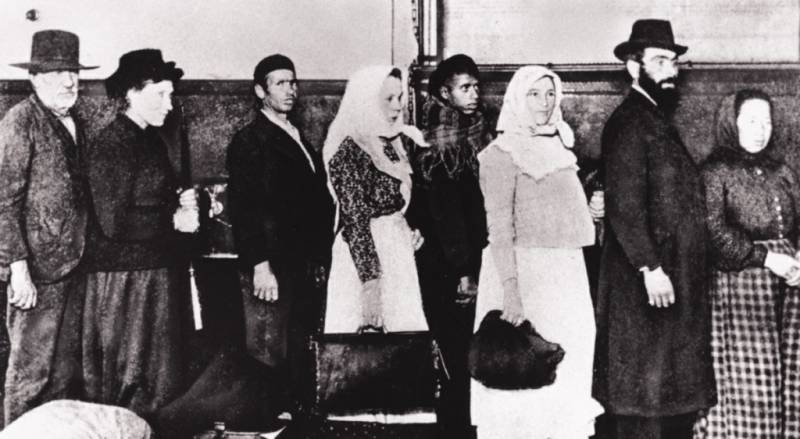
This photograph shows immigrants lining up at Ellis Island in its heyday. On November 12, 1954, the federal government of the United States shut down the Ellis Island immigrant reception station in New York Harbor.
From 1892 to 1924, the facility processed some 12 million immigrants. Nowadays, some 40 percent of Americans can trace their familial roots to this gateway to the New World, named for Samuel Ellis, a merchant who owned the land in the 1870s.
The island has been administered by the federal government since 1808 and has been operated by the National Park Service since 1965.
On January 2, 1892, Annie Moore, a 15-year-old Irish immigrant, became the first person to pass through the newly opened facility. Two years earlier, President Benjamin Harrison had designated it as America’s first federal immigration center. Before then, individual states took responsibility for processing newcomers to the United States.
The closure came after Arne Peterssen, a seaman detained there for having overstayed his shore leave, became the last person to be processed there. He returned to his native Norway.
For 32 years, third-class passengers arriving from European ports first alighted at the 27-acre island. There they underwent medical and legal inspections, lasting three to seven hours, to certify that they did not have a contagious disease or another condition that could make them a public burden. Some two percent of the new arrivals were denied entry and sent back to their home countries.
First- and second-class passengers bypassed Ellis Island. They were subject only to brief shipboard inspections before disembarking directly at their New York piers and passing through customs.
Under the Immigration Act of 1924, when immigrants first became subject to national quotas, their numbers dropped sharply. The law also enabled U.S. Consulates to process immigrants. The legislation changed Ellis Island from a processing center to a detention and deportation facility for illegal immigrants. During World War II, it became a military hospital and a U.S. Coast Guard training center.
Beginning in 1984, Ellis Island underwent a $160 million renovation, the largest historic restoration project in U.S. history. Six years later, the Ellis Island National Museum of Immigration opened to the public. Nowadays, it draws nearly two million visitors a year.
Shuttered for 60 years, Ellis Island’s South Side Hospital Complex was opened to visitors for the first time in 2014. Approximately one immigrant in 10 arriving at Ellis Island received medical attention there.
In its day, the 29-building complex was the largest U.S. Public Health Service Institution in the United States. Ill and infirm immigrants were treated and cured within its walls before being allowed to enter the country. Approximately 1.2 million of the 12 million immigrants who passed through Ellis Island received medical treatment at what might have been the most modern, comprehensive hospital in the nation. This facility included wards for obstetrics, mental health and contagious diseases. It also had laundry facilities and a morgue.

From 1892 to 1924, the facility processed some 12 million immigrants. Nowadays, some 40 percent of Americans can trace their familial roots to this gateway to the New World, named for Samuel Ellis, a merchant who owned the land in the 1870s.
The island has been administered by the federal government since 1808 and has been operated by the National Park Service since 1965.
On January 2, 1892, Annie Moore, a 15-year-old Irish immigrant, became the first person to pass through the newly opened facility. Two years earlier, President Benjamin Harrison had designated it as America’s first federal immigration center. Before then, individual states took responsibility for processing newcomers to the United States.
The closure came after Arne Peterssen, a seaman detained there for having overstayed his shore leave, became the last person to be processed there. He returned to his native Norway.
For 32 years, third-class passengers arriving from European ports first alighted at the 27-acre island. There they underwent medical and legal inspections, lasting three to seven hours, to certify that they did not have a contagious disease or another condition that could make them a public burden. Some two percent of the new arrivals were denied entry and sent back to their home countries.
First- and second-class passengers bypassed Ellis Island. They were subject only to brief shipboard inspections before disembarking directly at their New York piers and passing through customs.
Under the Immigration Act of 1924, when immigrants first became subject to national quotas, their numbers dropped sharply. The law also enabled U.S. Consulates to process immigrants. The legislation changed Ellis Island from a processing center to a detention and deportation facility for illegal immigrants. During World War II, it became a military hospital and a U.S. Coast Guard training center.
Beginning in 1984, Ellis Island underwent a $160 million renovation, the largest historic restoration project in U.S. history. Six years later, the Ellis Island National Museum of Immigration opened to the public. Nowadays, it draws nearly two million visitors a year.
Shuttered for 60 years, Ellis Island’s South Side Hospital Complex was opened to visitors for the first time in 2014. Approximately one immigrant in 10 arriving at Ellis Island received medical attention there.
In its day, the 29-building complex was the largest U.S. Public Health Service Institution in the United States. Ill and infirm immigrants were treated and cured within its walls before being allowed to enter the country. Approximately 1.2 million of the 12 million immigrants who passed through Ellis Island received medical treatment at what might have been the most modern, comprehensive hospital in the nation. This facility included wards for obstetrics, mental health and contagious diseases. It also had laundry facilities and a morgue.


